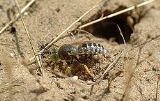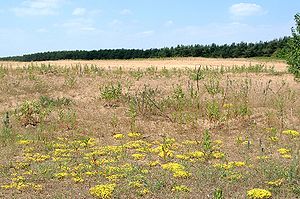
Bembix rostrata
Encyclopedia
Bembix rostrata is a protected species of sand wasp
native to Central Europe
. The genus Bembix - of which B. rostrata is among the most distinctive species - has over 340 species worldwide and is found mostly in warm regions with open, sandy soils; Australia
and Africa
have a particularly rich variety of species.
, and as far north as Denmark
and Sweden
.
stage. The female carefully re-seals the nest tube after each feeding. Because of this intensive maternal care, a female can raise at most only 8 larvae during the high summer. B. rostata is very faithful to its nest sites, often nesting in the same places year-on-year, even if these change over time and alternative habitats are available.
The species has become rare due to loss of large open-sand surfaces in warm areas, such as in the sand dunes of the upper Rhine Graben. It is also the host for several parasitoid
s in families such as Bombyliidae
, Conopidae
and Mutillidae
. A cuckoo wasp
which specialises in B. rostrata is Parnopes grandior.
The behaviour of B. rostrata led the famous naturalist Jean-Henri Fabre to conduct intensive studies of the species.

Sand wasp
The Bembicini, or Sand wasps, are a large tribe of crabronid wasps, comprising 20 genera. Bembicines are predators on various groups of insects. The type of prey captured tends to be rather consistent within each genus, with flies being the most common type of prey taken...
native to Central Europe
Europe
Europe is, by convention, one of the world's seven continents. Comprising the westernmost peninsula of Eurasia, Europe is generally 'divided' from Asia to its east by the watershed divides of the Ural and Caucasus Mountains, the Ural River, the Caspian and Black Seas, and the waterways connecting...
. The genus Bembix - of which B. rostrata is among the most distinctive species - has over 340 species worldwide and is found mostly in warm regions with open, sandy soils; Australia
Australia
Australia , officially the Commonwealth of Australia, is a country in the Southern Hemisphere comprising the mainland of the Australian continent, the island of Tasmania, and numerous smaller islands in the Indian and Pacific Oceans. It is the world's sixth-largest country by total area...
and Africa
Africa
Africa is the world's second largest and second most populous continent, after Asia. At about 30.2 million km² including adjacent islands, it covers 6% of the Earth's total surface area and 20.4% of the total land area...
have a particularly rich variety of species.
Distribution
B. rostrata ranges in distribution from Europe and the Mediterranean to Central AsiaAsia
Asia is the world's largest and most populous continent, located primarily in the eastern and northern hemispheres. It covers 8.7% of the Earth's total surface area and with approximately 3.879 billion people, it hosts 60% of the world's current human population...
, and as far north as Denmark
Denmark
Denmark is a Scandinavian country in Northern Europe. The countries of Denmark and Greenland, as well as the Faroe Islands, constitute the Kingdom of Denmark . It is the southernmost of the Nordic countries, southwest of Sweden and south of Norway, and bordered to the south by Germany. Denmark...
and Sweden
Sweden
Sweden , officially the Kingdom of Sweden , is a Nordic country on the Scandinavian Peninsula in Northern Europe. Sweden borders with Norway and Finland and is connected to Denmark by a bridge-tunnel across the Öresund....
.
Characteristics
B. rostrata displays distinctive behaviour in front of its nest, digging its burrows with fast, synchronised movements of its forelegs. In addition, the insect can turn very rapidly about its own axis, the flapping of its wings as it does this producing a buzzing sound reminiscent of a gyroscope. Its size (15–24 mm), striking yellow and black-striped abdomen and the labrum, extended into a narrow beak, are distinctive features.Behaviour
B. rostrata forms colonies of between a dozen and several hundred insects, where the females each construct a tube up to 20 cm long containing a single brood cell. This is stocked with dozens of insects, predominantly large flies (Tabanidae, Syrphidae), which provide the larva with food for its two-week development to the imagoImago
In biology, the imago is the last stage of development of an insect, after the last ecdysis of an incomplete metamorphosis, or after emergence from the pupa where the metamorphosis is complete...
stage. The female carefully re-seals the nest tube after each feeding. Because of this intensive maternal care, a female can raise at most only 8 larvae during the high summer. B. rostata is very faithful to its nest sites, often nesting in the same places year-on-year, even if these change over time and alternative habitats are available.
The species has become rare due to loss of large open-sand surfaces in warm areas, such as in the sand dunes of the upper Rhine Graben. It is also the host for several parasitoid
Parasitoid
A parasitoid is an organism that spends a significant portion of its life history attached to or within a single host organism in a relationship that is in essence parasitic; unlike a true parasite, however, it ultimately sterilises or kills, and sometimes consumes, the host...
s in families such as Bombyliidae
Bombyliidae
Bombyliidae is a large family of flies with hundreds of genera, although their life cycles are not well known. Adults generally feed on nectar and pollen, thus are pollinators of flowers. They superficially resemble bees, thus are commonly called bee flies, and this may offer the adults some...
, Conopidae
Conopidae
Conopidae, usually known as the thick-headed flies, is a family of flies within the Brachycera suborder of Diptera. Flies of the family Conopidae are distributed worldwide except for the poles and many of the Pacific islands. About 800 species in 47 genera are described worldwide, approximately 70...
and Mutillidae
Mutillidae
Mutillidae are a family of more than 3,000 species of wasp whose wingless females resemble ants. Their common name velvet ant refers to their dense pile of hair which most often is bright scarlet or orange but may also be black, white, silver, or gold. Their bright colours serve as aposematic signals...
. A cuckoo wasp
Cuckoo wasp
Commonly known as cuckoo wasps, the Hymenopteran family Chrysididae is a very large cosmopolitan group of parasitoid or cleptoparasitic wasps, often highly sculptured, with brilliantly colored metallic-like bodies...
which specialises in B. rostrata is Parnopes grandior.
The behaviour of B. rostrata led the famous naturalist Jean-Henri Fabre to conduct intensive studies of the species.


